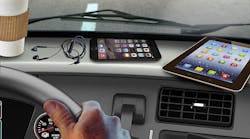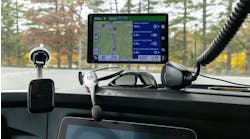“Driving, in some respects, is one of the biggest challenges for people, in terms of cognitive load,” renowned cognitive psychologist, Dr. Shlomo Breznitz, founder of CogniFit, told Fleet Owner in an interview back in 2008. “It is even more challenging than flying a plane in some respects because the amount of information that has to be processed quickly is so great. We are constantly reacting to estimates of speed and distance, attending to what is happening in front of us, as well as to the sides and behind us. We make decisions about the route to travel while reacting to road signs. We respond to visual events and to sounds.
“Human brains have just not evolved for that,” he said. “In human terms, the fastest we should need to react is the speed at which we can run, not the speed at which we can drive. I find it a miracle there are not more accidents than there are.”
Six years later, the distractions for drivers have only increased, with no miraculous, corresponding evolutionary leap forward in human brain development to handle the job. What humans have done, however, is begin to acknowledge (albeit somewhat reluctantly) a few cognitive shortcomings. Not an easy thing for a top-of-the-food-chain-type being to do.
The result has been an outpouring of technology to lend a much-needed hand with the task of driving. Adaptive cruise control systems now help drivers with the task of managing speed and following distance. Forward and side-vision cameras enhance visibility and navigation systems provide turn-by-turn driving directions, visibly and/or audibly.
You’d think that would be more than enough help, but none of these technologies have entirely compensated for the almost irresistible counter tug of the marvelous mobile communication device on a driver’s attention. According to Breznitz, this is all a part of being human, too.
Apparently, although people may like to think they are good at multi-tasking, people don’t really do that at all. “Instead,” Breznitz said, “we just switch very rapidly between tasks without losing our place. Problems occur when our brain is presented with a conflict for our attention. For example, if you are using your ‘visual’ channel to drive a vehicle and your cell phone suddenly rings, there is competition between the auditory and visual channels, and the auditory channel always wins.”
Breznitz explains that this is because audio information is always sequential. That is the only way people can process it, while visual processing is spatial; you can blink and not much changes or is lost in that time. The result is that the brain learns to pay more attention to auditory input. “This priority given to the audio by the brain actually blocks visual input, so that you can be looking right at something, but not really see it,” he noted. “It is just not registering.”
Add texting to the picture and it is double-trouble. No wonder the elimination of distracted driving is on the 2014 Top Ten Most Wanted List of advocacy and awareness policies for the National Transportation Safety Board.
An obvious first step for most fleets has been to adopt strict policies concerning distracted driving. According to a 2013 survey by Aegis titled “Measuring Corporate Attitudes to Employee Distracted Driving,” most companies (71%) have already done just that and those which have not said they were planning to implement distracted driving policies shortly. A perhaps surprising 41% of companies surveyed said their policies prohibited all use of cell phones while driving—with no exceptions.
In spite of these policy-setting initiatives, though, the same fleets reported a relatively low level of confidence in the results. Only 32% reported that they were “very confident” that the current methods are effective. Sixty percent said they were “somewhat confident,” while 8% reported that they were “not confident.”
Once more into the breach
Clearly bested by the addictive pull of the cell phone (and now tablets), businesses are further fortifying barriers against the use of distracting devices in moving vehicles. Some fleets, for example, are adding multiple other technologies to their existing policies and training efforts in an attempt to finally control distracted driving.
One of the combinations winning new supporters is the use of video recorders for driver performance monitoring plus advanced analytics to enable better driver coaching. Still other fleets are also adding systems or software designed to actually block talking or texting while driving to this safety technology mix.
“On the road, people are more at risk of being hit because of distracted drivers. It seems to get worse every day,” says Steve Mitgang, CEO of SmartDrive. “Fleets are more exposed, too, and realize that they have to react. As a result, we are seeing faster adoption of our technology.”
SmartDrive’s video-based driver monitoring system can also integrate with active safety systems such as adaptive cruise control to capture and understand more types of data that are earlier indicators of risk, Mitgang says.
“With data related to collision avoidance systems, for instance, even without hard-braking events, we can see signs of aggressive driving behavior, such as following too closely, when the system is always tapping the brakes for the driver,” he explains. “If the lane departure warning goes off, we can use the video to determine if the driver was just avoiding road debris or swerving because of a distraction like texting. Without the video, fleets don’t know the root causes of a particular maneuver.”
For some fleets, adding a technology to deny access to cell phones while driving can offer additional peace of mind.
Besides the core goal of keeping people safe, one problem for fleets and other employers is the issue of “contributory negligence,” says David Coleman, executive vice president-strategy and market development of CellControl. The company offers a windshield-mounted device that controls the use of cell phones while a vehicle is in motion—from completely disabling the devices, to blocking certain uses, allowing only hands-free use, or converting text to speech.
Many states now treat use of handheld cell phones as a primary offense, meaning drivers can be stopped and cited if they are observed using a handheld, even if they are doing nothing else illegal, such as speeding, he says. “Fleets just have to control their liability. We are addressing the challenge. When the vehicle is moving, we enforce a company’s policy [concerning cell phone use].
“We shouldn’t think of employees as bad because they need to use the phone,” Coleman adds. “Good drivers want to respond to customers, of course.
“Usage-limiting technologies like ours help drivers to defend their actions, such as not responding at once to a text while driving. It makes things easier for them. It all comes down to social responsibility, to corporate culture,” he adds. “This is not about privacy. It is about helping your drivers to do the right thing.”
The perfect “butler”
With more cars and trucks on the road today, driver distraction is an important issue that needs to be addressed as part of an overall effort to reduce accidents and make our roads and highways safer,” observes Jim Sassen, senior manager of product marketing for Omnitracs. “Drivers are being asked to do more and more in-cab tasks and commonly have several devices to help them communicate, navigate and be more productive and connected throughout their day. These devices are in addition to the standard truck gauges and in-cab hardware that they also have to manage.
“To this end, it is unlikely that these technologies or driver requirements are going to go away,” he continues. “That is why, at Omnitracs, our goal is to design, develop and integrate solutions that minimize distraction and promote safe driving by helping fleets and drivers access information more intelligently...and ultimately maximize driver focus on safe and low-stress driving.”
“Distracted driving is all about safety,” says Erin Cave, vice president of product management, mobile for Telogis. “A distracted driver is an unsafe driver. Part of my role is to provide as much functionality as possible, but in a non-intrusive way.”
“Non-intrusive” might well be the bumper sticker for technology suppliers to the trucking industry today. The new goal is not to capture everybody’s attention, but to be the invisible, unnoticed, best darn helper a driver or fleet, ever had.
“Years ago, there were no ‘devices,’” says Cave. “Drivers then were probably distracted in very different ways. Say what you will, but we’ve come a long way [as an industry]. Our job is to innovate and to do whatever we can. There is no doubt about it; we really are safer today. We haven’t just traded one kind of distraction for another.
“We are not going back,” Cave adds. “ There will be more and new ways to help drivers coming up. I can’t even imagine what 20 years from now will look like.”
No cell phone use while driving
DeCrescente Distributing Co. (DDC) started in 1948 as a family-owned business based in Mechanicville, NY. The beverage distribution company has a fleet of about 75 company-owned vehicles, including 55 Class 8 trucks that are used to deliver about 10 million cases of assorted beverages per year to some 2,500 to 3,500 customers, including restaurants, bars, grocery stores and convenience stores.
For the past three years, the company has been named one of the best places to work in New York state, and Tom Turcotte, operations manager for DDC, likes it that way. Turnover is low and DDC works hard to keep drivers safe and happy.
“We have a very strong safety focus,” Turcotte says. “We want to keep our people safe inside and outside our facility.
“Mobile phones are a part of our reality, and we already had strict policies concerning their use while driving. We use DriveCam units from Lytx, though, and thanks to DriveCam, we noticed that a few instances of hard-braking were tied to cell phone use while driving,” he continues.
“Hands-free use of cell phones via Bluetooth was really no better than picking up the phone when it came to safety. Even though hands-free cell phone use is still legal in New York, we decided to block usage entirely while a vehicle is in motion. We want to keep our drivers, not have to let them go because of problems with cell phone use.”
To do that, DDC turned to CellControl’s technology to block inbound and outbound calls and texting while a vehicle is in motion. There were adjustments to be made, of course, according to Turcotte, but drivers found it worked well, he says. Now they are not distracted by calls and texts while driving and they still have plenty of time to return calls when they are at a stop.
“Management had to adjust some, as well,” he recalls. “The instant gratification of reaching a driver right away was gone; we had to learn to be patient.”
DeCrescente’s three-tiered approach to managing mobile communications—with its blending of company cell phone use policies, video performance monitoring of drivers and limiting cell phone use while driving—is an approach that appears to be gaining some traction industry-wide.
“Our people have bought into this safety culture,” Turcotte adds. “They give us ideas and feedback [about how to keep making things better].”
Regulations, federal and state
Having largely failed to persuade drivers to voluntarily make safe choices when it comes to using cell phones and other mobile devices while driving, federal and state regulatory agencies are clamping down with regulations, laws and penalties in an effort to get drivers to focus on the task of driving—and only driving—while they are on the highway.
In October of 2010, the Federal Motor Carrier Safety Administration (FMCSA) published a rule prohibiting texting by commercial motor vehicle drivers while operating in interstate commerce and imposing sanctions, including civil penalties and disqualification from operating in interstate commerce, for those who fail to comply. Motor carriers are also prohibited from requiring or allowing their drivers to engage in texting while driving.
Just over a year later, FMCSA issued its Final Rule also restricting the use of handheld mobile telephones.
Vermont is the first state to ban the use of all cell phones while driving, either handheld or hands-free. Many other states ban the use of all handhelds while driving.
Almost all states (plus the District of Columbia, Puerto Rico, Guam and the U.S. Virgin Islands) now ban texting for all drivers.
The government distracted driving site (www.distraction.gov/content/get-the-facts/state-laws.html) is a good place to go for state-by-state details.
Following are some highlights from the site. Check the site for further information and more specifics, especially concerning bans for bus drivers and novice drivers.
- Alabama: Bans all cell phone use for novice drivers and texting for all drivers.
- Alaska: Bans texting for all drivers
- Arizona: Bans all cell phone use for school bus drivers
- Arkansas: Bans the use of handhelds for drivers 18-21. Bans texting for all divers
- California: Bans the use of handhelds for all drivers
- Colorado: Bans all cell phone use for novice drivers and texting for all drivers
- Connecticut: Bans the use of handhelds for all drivers
- Delaware: Bans the use of handhelds for all drivers
- District of Columbia: Bans the use of handhelds for all drivers
- Florida: Bans texting for all drivers
- Georgia: Bans texting for all drivers
- Guam: Bans the use of handhelds for all drivers
- Hawaii: Bans the use of handhelds for all drivers
- Idaho: Bans texting for all drivers
- Illinois: Bans the use of handhelds for all drivers and all cell phone use for bus drivers and novice drivers
- Indiana: Bans texting for all drivers
- Iowa: Bans texting for all drivers
- Kansas: Bans texting for all drivers
- Kentucky: Bans texting for all drivers
- Louisiana: Bans texting for all drivers
- Maine: Bans texting for all drivers
- Maryland: Bans the use of handhelds for all drivers
- Massachusetts: Bans texting for all drivers
- Michigan: Bans texting for all drivers
- Minnesota: Bans texting for all drivers
- Mississippi: Bans all cell phone use (handheld and hands-free) for bus drivers; bans texting for novice drivers
- Missouri: Bans texting for novice drivers
- Montana: No current bans for distracted driving
- Nebraska: Bans texting for all drivers
- Nevada: Bans the use of handhelds for all drivers
- New Hampshire: Bans the use of handhelds for all drivers
- New Jersey: Bans the use of handhelds for all drivers
- New Mexico: Bans the use of handhelds for drivers with in-state vehicles and bans texting for all drivers
- New York: Bans the use of handhelds for all drivers
- North Carolina: Bans texting for all drivers
- North Dakota: Bans texting for all drivers
- Ohio: Bans texting for all drivers
- Oklahoma: Bans the use of handhelds for drivers with a learner’s permit or intermediate license
- Oregon: Bans the use of handhelds for all drivers
- Pennsylvania: Bans texting for all drivers
- Rhode Island: Bans texting for all drivers
- South Carolina: Bans texting for all drivers
- South Dakota: Bans texting for all drivers
- Tennessee: Bans texting for all drivers
- Texas: Bans all cell phone use for bus drivers and novice drivers
- Utah: Bans texting for all drivers
- Vermont: Bans all cell phone use (handheld and hands-free) for drivers of all ages effective October 2014
- Virgin Islands: Bans the use of handhelds for all drivers
- Virginia: Bans texting for all drivers
- Washington: Bans the use of handhelds for all drivers
- West Virginia: Bans the use of handhelds for all drivers
- Wisconsin: Bans texting for all drivers
- Wyoming: Bans texting for all drivers



